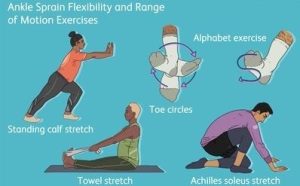
Putting Your Best Foot Forward
Nice weather is the perfect excuse to get outside and be active. Whether you’re running a 5K, playing pickleball or taking a walk in the park, it’s crucial to take care of your feet.
Your feet and ankles work together to efficiently support your body weight, absorb impact and propel the body forward with each step. To learn more about these essential functions and how to properly look after your feet, we asked Cameron Orthopedics’ podiatrist, Dr. Matthew Sieloff, to weigh in.
Picking the Right Pair
According to Dr. Sieloff, choosing the right shoe is incredibly important to long-term foot health. Your footwear choice should be tailored to the activities you regularly participate in to optimize performance and reduce the risk of injury.
Before shopping for new shoes, determine your foot type by evaluating characteristics, such as arch height and pronation, the inward rolling motion of the foot during movement. The three common foot types are neutral arch, high arch and low arch/flat foot.
After you determine your foot type, Dr. Sieloff recommends shopping at a specialized store where you can get assistance from professionals. When trying on shoes, try jogging or walking around in them to assess their comfort. If you use orthotic devices or custom insoles, bring them along to ensure proper fit and support. The shoes you select should be flexible enough to accommodate the natural movement of your feet. They should also bend and flex at the appropriate points to promote natural gait and foot mechanics.
Warm It Up
Warming up before exercising is import
ant in preventing foot injuries. Dr. Sieloff recommends beginning with five to 10 minutes of light aerobic activity such as jogging, cycling or brisk walking. This will increase blood flow to your muscles, raise your body temperature and prepare your cardiovascular system for more intense exercise.
Dynamic stretching can also help prep your feet and ankles for exercise by moving your muscles and joints through a full range of motion in a controlled manner. This will help improve flexibility and mobility and activate the muscles you will be using during your activity. Focus on dynamic stretches that target the major muscle groups of your lower extremities, such as leg swings, walking lunges and high knees. For high-intensity or cardio-focused exercises, consider running through dynamic movements like jumping jacks and glute kicks.
If you are engaging in a specific sport or activity, Dr. Sieloff suggests incorporating movements that replicate the actions involved. For example, if you are playing basketball, try including sideways slides, pivots and jump shots.
“Remember, warming up and stretching alone cannot prevent all injuries,” said Dr. Sieloff. “It is important to gradually increase the intensity of your activity, use proper form and technique, and listen to your body. If you have specific concerns or conditions, you should consult with a healthcare professional or a qualified trainer for personalized guidance.”
Take a Breather
Allowing for adequate rest and recovery between workouts or training sessions can also help prevent injuries. Fatigue and overuse are common contributors to foot and ankle injuries. Listen to your body by giving it time to heal and rejuvenate. Dr. Sieloff says incorporating cross-training and conditioning exercises into your routine can help strengthen the entire lower body, improve balance and reduce the risk of overuse injuries. Most importantly, Dr. Sieloff encourages patients to listen to their bodies and pay attention to any pain, discomfort or unusual sensations in their feet and ankles. If you experience persistent pain or notice any swelling or instability, seek medical attention promptly to prevent further damage.
When to Seek Medical Attention
Accidents and injuries happen but when is it time to see a doctor? If you experience any of the following, Dr. Sieloff says it is time to reach out and seek medical attention for foot- and ankle-related injuries.
- Recurring or Chronic Injuries. If you have a history of recurring sports injuries or chronic pain, it is important to see a healthcare professional who can assess the underlying cause and provide appropriate management strategies.
- Severe Pain. If you experience intense or persistent pain that does not improve with rest, ice or over-the-counter pain medications, it is best to consult a doctor.
- Swelling and Bruising. If the injured area becomes noticeably swollen, bruised or begins to show signs of inflammation, it may indicate a more significant injury that requires medical attention.
- Limited Mobility or Inability to Bear Weight. If you are unable to move the injured body part properly or cannot put weight on it, it could be a sign of a fracture, severe sprain or another significant injury.
- If the injured area appears deformed, misaligned or out of its normal position, this suggests a fracture or dislocation. You should seek immediate medical attention.
- Prolonged or Worsening Symptoms. If your symptoms persist for more than a few days or continue to worsen despite self-care measures, it is advisable to consult a doctor for a proper evaluation and diagnosis.
Interested in learning more about how to prevent injuries to your feet and ankles? Schedule an appointment with Dr. Sieloff and the team at Cameron Orthopedic Services by visiting CameronMCH.com/find-a-provider-schedule.
©2024 Cameron Memorial Community Hospital
416 E. Maumee Street, Angola, IN 46703


Recent Comments